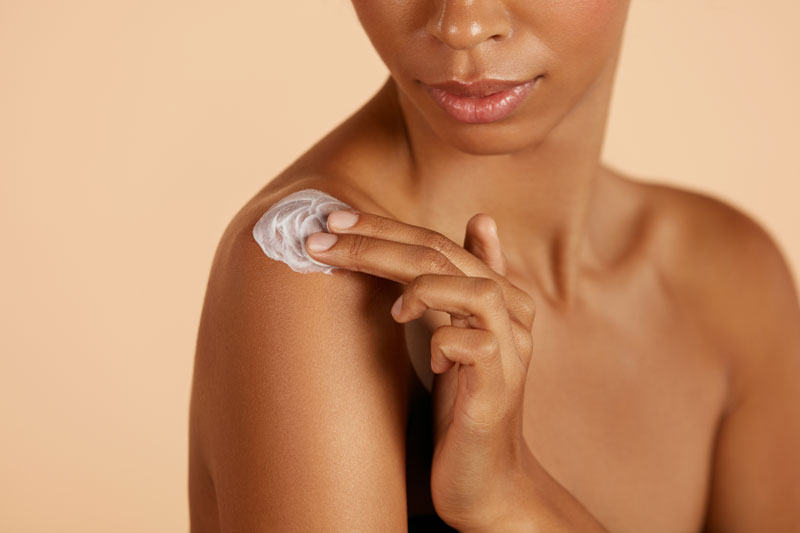We’ve talked about it before, and we will surely talk about it again: toxic ingredients in skincare. We’re told the importance of reading food labels, but beauty product labels are often put on the back burner. An average woman uses 12 products with more than 168 chemicals in them every single morning. Research shows that most of these chemicals are hormone disruptors, which throw hormone levels out of whack and can cause many side effects, including mood swings, anxiety, insomnia, weight issues, skin problems, cancer, and more!
How Hormone Disruptors Work
Our endocrine system is our hormonal system. It includes our adrenals, ovaries, thyroid, pancreas, hypothalamus, and pituitary gland. Endocrine-disrupting chemicals are substances from our food, water, environment, and personal care products that mess with the production, transportation, breakdown, binding, and elimination of hormones. These chemicals impact the balance of the body, which can harm the thyroid, fertility, adrenal, blood sugar, and more. Because we have these bandits coming at us from every angle, it’s essential to reduce exposure wherever we can. Enter skincare.
Skincare is one of the first places to start when reducing exposure to hormone disruptors. It’s incredible how many success stories I’ve heard when women clean up their skincare. They can finally get pregnant (and no miscarriages!), they don’t have crazy PMS symptoms anymore, they drop to a healthier weight, their energy levels go up, and brain fog goes away. Let’s dive into the top 5 toxic skincare ingredients to avoid healthy hormones.
TRUTH BOMB:
You’re
Already killing it!
If You Were More Consistent With Your Wellness Routine, You’d Be Unstoppable.
5 Toxic Ingredients in Skincare
Parabens
Parabens include anything that starts with propyl, isopropyl, butyl, isobutyl. These chemicals are used as preservatives in many body products. A study published in the Journal of Applied Toxicology in 2004 found parabens in breast tumors and explains their estrogen-mimicking properties. Because these chemicals mimic estrogen, they create an excess of estrogen in the body, which can lead to:
- Irregular vaginal bleeding
- Depression
- Anxiety
- Mood swings
- Heavy periods
- Uterine fibroids
- Endometriosis
- Hormonal migraines and headaches as estrogen drops
- Cervical dysplasia
- Unexplainable Weight loss/weight gain
- Water retention
- Short menstrual cycles (less than 21 days)
- Cyclic breast tenderness
- Hypothyroidism
- Endometrial hyperplasia
- Breast, ovarian, and endometrial cancers
- Endometriosis
Now, this study was more than 15 years ago! A lot of companies have finally woken up to the danger of parabens, but it took them a while. Some companies are still using parabens, so please check your ingredients list and chuck it in the trash if you spot parabens.
Fragrance
Did you know that when you see fragrance on an ingredients list, it can be a chemical concoction of over 3,000 known carcinogens and endocrine-disrupting chemicals?! Fragrance is a sneaky ingredient because it’s also sometimes called “parfum” or “perfume”. Keep your eye out for these!
Phthalates, one class of chemicals typically found in fragrance and plastic, can disrupt hormones, cause cancer, infertility, and more. Whenever you see fragrance on an ingredients list, do not buy it!
Here is one wild study to really drive this home.
Breast Cancer Prevention Partners tested 32 commonly used personal care and cleaning products from around the country. In the report, “Right to Know: Exposing Toxic Fragrance Chemicals in Beauty, Personal Care, and Cleaning Products,” they found:
- 338 fragrance chemicals were used in 25 personal care products tested, but not labeled
- 75% of the chemicals had been linked to chronic health effects, including cancer, birth defects, neurotoxicity, hormone disruption, and respiratory harm
- Several products contained chemicals linked to breast cancer, including hormone-disrupting compounds with links to breast cancer including oxybenzone (chemical sunscreen!!), propylparaben (preservative), and phthalates
Triclosan
Our own government agency, the FDA has criticized triclosan for its harmful effects on hormones, despite it still being allowed in soaps and other skincare products. Short-term (not even long-term!!) animal studies found that exposure to high doses of triclosan is linked to a decrease in thyroid hormones. When our thyroid levels are thrown out of balance, we can experience extreme fatigue, hair loss, weight gain/loss resistance, and more.
Even though the study looked at high doses of triclosan, it’s important to remember that small, consistent use of an ingredient leads to high doses. Just because you may not be dosing a high amount every day doesn’t mean it won’t have an impact.
Lead
Yup, you read that right. Lead is in conventional cosmetics like mascara, lip products, shampoos, blushes, eye shadows, body lotions, and more. The FDA recently released data showing over 99% of cosmetic lip products and externally applied cosmetics on the U.S. market contain lead below 10 ppm. That’s an insane number.
According to the Environmental Working Group, lead is one of the top 12 hormone-altering chemicals to steer clear of. Lead harms almost every organ system in the body and has been linked to a number of health problems, including permanent brain damage, miscarriage, premature birth, kidney damage, nervous system issues, and increased blood pressure.
We know lead is bad, but most of us don’t know that it is toxic to our hormones. Animal research has shown that lead lowered sex hormone levels and disrupted HPA axis signaling (our stress regulating system). The HPA axis is also responsible for signaling the firing of adrenal hormones. If our HPA axis is dysregulated, we can experience adrenal fatigue symptoms, including debilitating anxiety, depression, hair loss, extreme tiredness, brain fog, and more.
To keep your hormones balanced and functioning properly, it’s essential to eliminate personal care products that contain lead. Check out our articles on our favorite all-natural organic skincare products, makeup, and body care for alternatives.
Carcinogens
It should be a no-brainer to stay away from carcinogens, but unfortunately, skincare companies don’t include “known-carcinogen” on their ingredients list. Formaldehyde and formaldehyde-releasing preservatives are common in personal care products. They may show up as quaternium-15, diazolidinyl urea, imidazolidinyl urea, DMDM hydantoin, 2-bromo-2-nitropropane-1,3 diol, benzene, untreated mineral oils, ethylene oxide, chromium, and cadmium.
Now, as we learned, a lot of conventional skincare ingredients mimic estrogen. Estrogen dominance and excessive hormonal stimulation of cell proliferation increase the risk of cell mutation, which means they can act as potent carcinogens. These endocrine-disrupting and carcinogenic chemicals have been linked to the genesis of prostate, uterine, breast, ovarian, testicular, thyroid, and bone cancers. Even an excess of progesterone, oestrogen, and testosterone has been linked to the development of cancers. It’s important to understand that because these chemicals are throwing hormone levels out of whack, that chronic, long-term exposure may lead to carcinogenic effects.
I hope this article has helped you understand the dangers of conventional skincare products and which ingredients to avoid for happy hormones. Staying in balance is crucial for staying healthy. If you feel like you are experiencing hormonal imbalances, start with your swapping out your conventional skincare! Ditching these dangerous chemicals may help you immensely!





READ the Latest
Longevity
Health Habits
Health Habits
Longevity
3 Comments